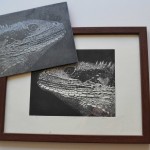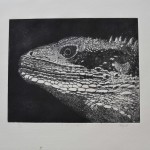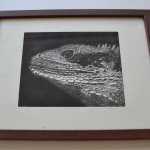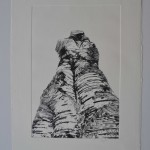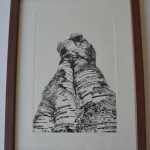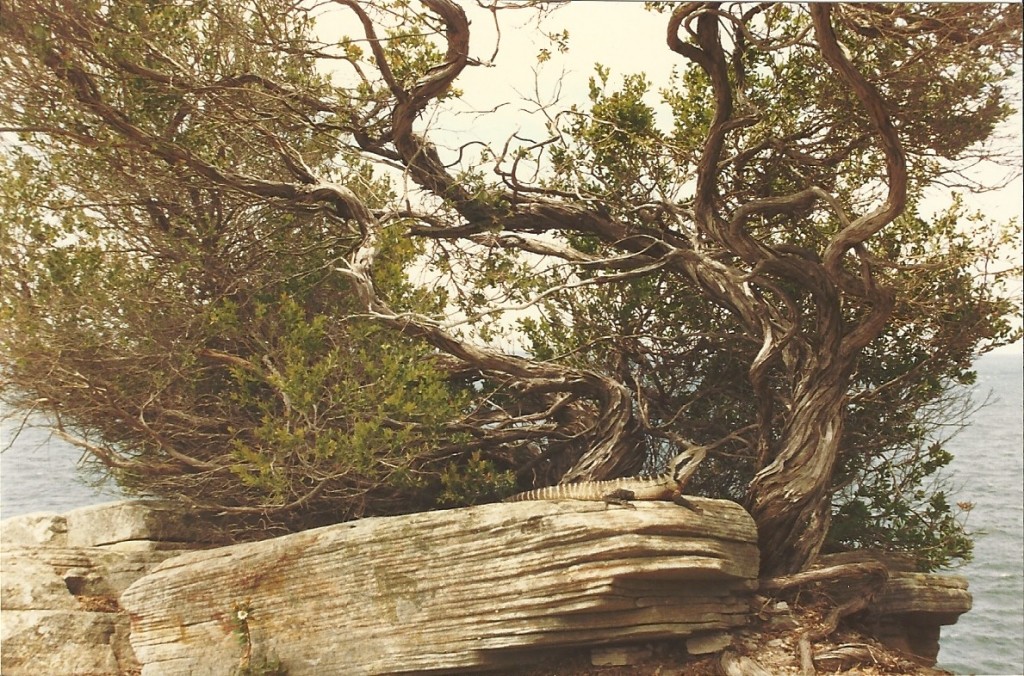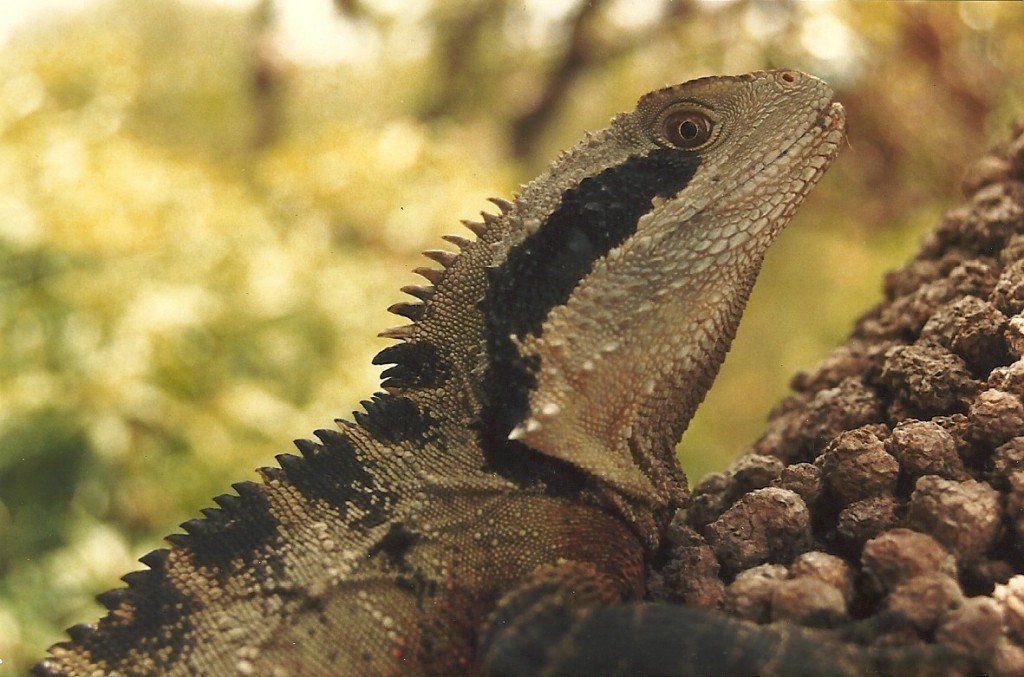This took a long time…
When I decided that I was going to make etchings, one of my aims was to develop some of the skills of the great 19th century natural history illustrators. When I was a child, I marvelled at Ernst Haeckel’s Kunstformen der Natur and, when I got hold of the appropriate materials, I wanted to do something of my own that might approach the weird brilliance of those images.
When I lived in Manly (Sydney) in 1989, I found an Eastern Water Dragon (Physignathus lesueurii) outside my house. He lived in the house for a few days until I released him into the wilds of North Head.
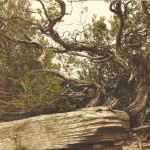
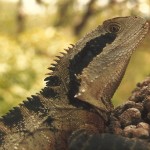 Click on any of these for larger versions.
Click on any of these for larger versions.
He was a classic dragon and it was he whose image I wanted to use.
I did some hard and soft ground etchings of plants from Kew Gardens until I thought I was ready to tackle my Dragon Project.
These were the stages:
1. Cover the zinc plate with wax (hard resist). Let it set.
2. Engrave the picture of the dragon into wax. This took about 40 hours. It’s quite intricate.
3. Etch in mordant solution using a swan feather to brush away bubbles. The swan feather seems to be standard equipment in etching.
4. Use a mordant-resistant paint to cover the parts of the plate that I want to be light-coloured on the final print.
5. Using bunsen burners in a chemistry lab fume cupboard, heat the plate, then sprinkle it with a hideous dust. Where it lands on the plate, it stays there. The plate is now coated with uniform dots.
6. Etch the cooled plate in mordant. The unpainted parts are now etched with a uniform pattern of tiny pits. The original etched lines are still visible.
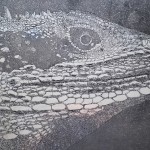 7. Soak the plate in turpentine and scrub until everything is off. Paint the parts of the plate that I want to be very light coloured in the print.
7. Soak the plate in turpentine and scrub until everything is off. Paint the parts of the plate that I want to be very light coloured in the print.
8. Repeat the fume cupboard treatment, etching and scrubbing. After 80 hours of work, I now have the finished plate.
9. Soak several sheets of printing paper, ink up the plate and try to prepare it so that there is a decent amount of ink in the lines and pits but none on the high parts or the edges.
10. Place the plate face up on the bed of the roller. Take a sheet of paper from the water bath, squeeze the paper to remove excess water and lay it on top of the plate. Place a felt blanket over the paper and run the bed through the roller. Surprisingly good arm exercise, this.
11. Remove the blanket, then very carefully take the paper from the plate.
12. Clean everything and start 9 and 10 again. Repeat dozens of times until you get a plate that you like.
A far easier method is drypoint. You etch directly onto the plate. No shading but it’s probably closer to that 19th century effect for which I was aiming. Here’s a silver birch. My favourite print.

Posted November 11, 2013 Posted by Adam in Uncategorized
I’m thinking of producing a classification of Australian Lizards based on their bites…
Shingleback, Sleepy Lizard (Tiliqua rugosa) – huge mouth but surprisingly painless, lets go immediately
Common Bluetongue (Tiliqua scincoides) – Big mouth, more painful than Sleepy, hangs on longer.
Eastern Water Dragon (Physignathus lesueuri) – real pain here, it clamps on like a jagged nutcracker and adjusts its grip occasionally, mashing a finger fairly convincingly. These could swim to the bottom of a swimming pool and stay there for three hours.
Central Bearded Dragon (Pogona vitticeps) – a bit of a sweetie, this one. I think these only bit me when they were eager for whatever food I was giving them.
Common Bearded Dragon (Pogona barbata) – more likely to bite and bite harder than the central beardies. Still not too bad.
Golden Water Skink (Eulamprus quoyii) – A beast. A small skink, looks fairly harmless until it latches onto your hand and doesn’t let go. A black fingernail at the very least. Several species of striped skink also bit me but I could never work out an identification to species level. They were innocuous compared to the Golden Water Skink.
Cunningham’s Skink (Egernia cunninghami) – Painful. Another one that grabs and doesn’t let go except to adjust its grip when it senses that you’ve lost a bit of attention.
Frilled Lizard (Chalamydosaurus kingii) – Afer all that energy expended on the threat display, the frilled lizard desn’t seem to have much left for the bite. A quick nip at most. Can draw blood but its heart’s not in it.
Long-nosed water dragon (Physignathus longirostris) – An amazing beast. We called them bicycle lizards as they ran on two legs. I don’t know whether they can do the basilisk trick on water. Sharp, painful bite that they inflicted quickly, then tried to run away.
Stoke’s (Gidgee) Skink (Egernia stokesii) – similar in appearance to the Cunningham’s Skink but nowhere near as virulent in the bite department. Gidgees didn’t seem to have that killer instinct of hanging on and on.
Gould’s (Sand) Goanna (Varanus gouldii) – Surprisingly non-injurious considering the size of the beast. Draws blood but then calls it quits. My brother was bitten by a Perentie (Varanus giganteus), which pierced an artery and sent spurts of blood the length of an EK Holden. He needed several stitches.
Pygmy Ridgetailed Monitor (Varanus acanthurus brachyurus) – needs a very good excuse to bite someone. It’s small and inoffensive. I think bites were mistakes, when I had been preparing mince mixed with egg and the poor thing couldn’t tell the difference between my hand and its food.

